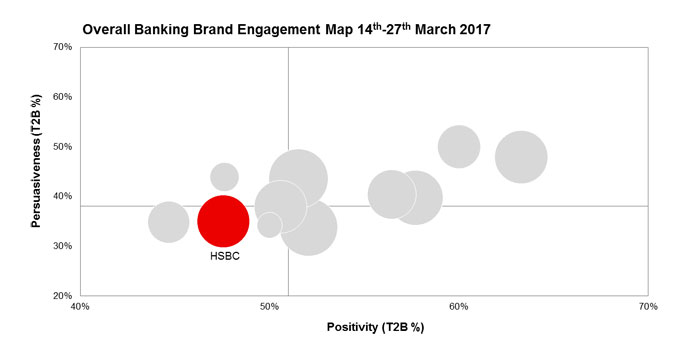In the wake of negative press coverage, financial services brands are particularly vulnerable to the consumer's experience turning from a positive one into a negative one. MESH's Fiona Blades explores how brands have coped and dealt with the predicament.
Retail banking has suffered with negative news across the sector. With costly implications for each brand, handling marketing communications is never more important than during a period of negative coverage.
At my company, MESH, we have been tracking people’s experience of brands in real time, using a methodology that picks up every way people are encountering banks whether through TV advertising, mobile banking apps or news.
During two weeks in March, we noticed three types of negative news for banks to contend with, each with a different impact requiring a different response from marketing.
When the Bank of England announced that the Co-operative Bank lacked stability, the overwhelming emotional response was sadness. (Quotes are from real-time respondents.)
“I was watching the news with my partner when they discussed the financial losses of the bank. It made me sad to see a great institution fail.”
TV, In the News, Co-operative Bank, Fairly Negative, Much Less Likely to Choose
People liked the Co-op TV advertising which would probably have pre-tested well.
“It was really different. Made me pay attention… Definitely piqued my interest!”
TV, Co-operative Bank, Very Positive, Much More Likely to Choose
And in terms of response to TV encounters, Co-Op’s were in the Top 3 for positivity.

Interestingly it is not so much trust that negative news impacted, but reliability.
“Read an article saying the bank may be orderly wound down. Very sad since this is one of the only trustworthy banks.”
Co-op, Newspaper, News, Very Negative
So what should a company faced with this situation do?
- Keep focussed on the number of people picking up the news. If someone is buying a financial product they will be more alert to news and will speak with friends.
- Consider whether there is a better way of using the media. In the case of the Co-op, having advertising that indicated the response the bank was taking to the Bank of England’s announcement. One bank faced with a computer failure used advertising to announce bank openings on a Saturday – a great idea!
Both NatWest and Barclays announced branch closures. We saw people feel negative about job losses and the impact on vulnerable people when their branch closes. However, clearly the press releases have been carefully worded to demonstrate that branch closures are not about increasing profits but reflect the way people are banking online and through mobile apps.
“It was announced on BBC News that NatWest will be closing branches … due to less customers visiting and more using online banking. There’s been a large decline in using branches since 2010.”
TV, NatWest, Fairly Negative, No Difference
In this type of situation, how should a brand respond?
- By placing the news in the context of changing consumer trends, (as we see here) the impact on customer perception is lessened. Brand communication should continue. This is sector-wide news rather than brand specific.
- Brand messaging needs care but can actually capitalise on the trends! NatWest ran ads for its award-winning mobile app which received positive responses.
“NatWest was voted number one banking app.”
NatWest, Newspaper, Very Positive, Slightly more likely to Choose
The final negative news stories generated anger from participants. They touch on morality rather than changing consumer trends or poor financial performance.
HSBC CEO was criticised for trying to claim Non-Dom status.
“HSBC CEO is trying to set up a Trust as a non-DOM and is being investigated by Revenue and Customs – lock him up and throw away the key.”
Newspaper, HSBC, Fairly Negative, Much Less Likely to Choose
Another story related to money laundering.
“UK banks accused of laundering Russian criminal money. Confirms my suspicions about the poor moral standards of HSBC.”
Social Media, HSBC, Very Negative, Much Less Likely to Choose
It is not surprising that the combination of overall experiences (Paid, Owned and Earned) put HSBC behind the majority of other banks.

How should a brand in this situation respond?
- This is not the time to launch a major new campaign. However, the few TV experiences we see for HSBC are not negative. This would suggest that some form of low level continuity might be the best strategy.
- Strong product advertising communicating simple benefits for the customer may continue to drive sales:
- Those needing certain products may not have seen the negative news in the press if news is at a low level.
- Unlike the Co-op where reliability is an issue (and a fear personal money could be lost), the response to HSBC is dislike. Despite this people will still buy products they want.
- As long as the advertising is not hypocritical (which could provoke a backlash) people may emotionally disconnect the corporate management, seen as corrupt, with the local or personal banking manager who is well liked.
In three different situations, generating sadness, acceptance and anger, negative news needs different responses. By keeping a finger on the pulse of how people are encountering brands, marketers can respond appropriately.


